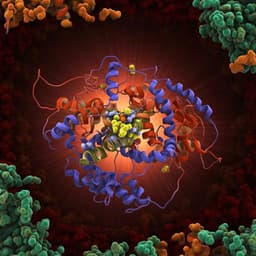
Chemistry
Branching mechanism of photoswitching in an Fe(II) polypyridyl complex explained by full singlet-triplet-quintet dynamics
T. Rozgonyi, G. Vankó, et al.
Discover how irradiation with visible light triggers the transformation of Fe(II) polypyridines from low-spin to high-spin states. This groundbreaking study, conducted by Tamás Rozgonyi, György Vankó, and Mátyás Pápai, delves into the dynamic photophysical processes of the [Fe(terpy)₂]²⁺ complex, unveiling sub-picosecond dynamics and intriguing breathing oscillations.
~3 min • Beginner • English
Introduction
Ultrafast femtosecond optical and X-ray experiments have been widely used to probe excited-state dynamics, but complex transition-metal systems often yield ambiguous mechanistic interpretations. In prototypical Fe(II) polypyridyl complexes such as [Fe(bipy)₃]²⁺ and [Fe(terpy)₂]²⁺, visible-light excitation promotes the system from a low-spin singlet ground state to MLCT states and subsequently to a quintet high-spin state in under 200 fs. However, it remains debated whether the high-spin state is populated directly via a ³MLCT→⁵MC pathway or sequentially via ¹,³MLCT→³MC→⁵MC involving a triplet metal-centered intermediate. Time-resolved optical data have been interpreted to support a direct mechanism, whereas X-ray emission spectroscopy, sensitive to metal spin states, indicates involvement of a ³MC intermediate, suggesting a sequential pathway and even possible branching. Theoretical treatments to date have been constrained by reduced dimensionality or rate models with uncertainties in intersystem crossing rates, leaving the controversy unresolved. The present study addresses this by simulating the full singlet–triplet–quintet dynamics of [Fe(terpy)₂]²⁺ in all nuclear degrees of freedom, aiming to establish the operative mechanism and assess the role of possible branching and coherent nuclear motion.
Literature Review
Previous ultrafast studies using transient optical absorption, X-ray absorption, and X-ray emission spectroscopy established sub-200 fs population of the quintet high-spin state following MLCT excitation in Fe(II) polypyridines. Conflicting mechanistic interpretations persist: optical measurements have been taken to support a direct ³MLCT→⁵MC transition, whereas X-ray emission investigations clearly detect ³MC participation, supporting a sequential ¹,³MLCT→³MC→⁵MC mechanism. UV photoemission suggested branching between mechanisms. Theoretical efforts employing Fermi’s golden rule or low-dimensional quantum dynamics provided insights but were limited by neglect of nuclear motion, simplified electronic structure, or large uncertainties in ISC rates, preventing resolution of the debate. This work builds on these findings by employing a full-dimensional spin-vibronic trajectory surface hopping framework including all relevant spin manifolds to discern the mechanism and its branching.
Methodology
The study employed full-dimensional trajectory surface hopping (TSH) with a linear vibronic coupling (LVC) model to simulate coupled singlet–triplet–quintet dynamics. A hybrid electronic-structure approach combined TD-DFT potential energy surfaces with SOCs from multiconfigurational perturbation theory. LVC potentials were obtained at the B3LYP/TZVP level, using RI-J and COSX approximations and the Tamm-Dancoff approximation for TD-DFT. Singlet and triplet excited states used RKS-referenced TD-DFT; quintet states used unrestricted DFT references. Solvent effects on excitation energies at the Franck–Condon geometry were checked with C-PCM for water and found to be small (≤0.02 eV). SOC matrix elements were computed with CASSCF/CASPT2: an active space of 10 electrons in 16 orbitals comprising Fe 3d (t2g, eg), Fe 4d (t2g, eg), two Fe–N σ-bonding 3d-eg, and four ligand-based π* orbitals to describe MLCT states. ANO-RCC basis sets were used with contractions of (7s6p5d4f3g2h) on Fe, (4s3p1d) on N, (3s2p) on C, and (2s) on H. CASPT2 employed an imaginary level shift of 0.2 a.u. and IPEA shift of 0.25 a.u.; core orbitals were frozen (and Fe 3s/3p also frozen in CASSCF). Calculations used state averaging over up to 30 roots for certain symmetries; MS-CASPT2 energies and SO-SI with an effective mean-field SOC Hamiltonian were used; scalar relativistic effects were treated with the DKH Hamiltonian. TSH followed Tully’s fewest switches with a three-step propagator and local diabatisation. Nuclear and electronic time steps were 0.5 fs and 0.005 fs, respectively. Initial conditions (1000) were sampled from a ground-state Wigner distribution and stochastically filtered by excitation energy and oscillator strength within a 0.1 eV window centered at 2.358 eV (lowest bright MLCT at FC), yielding 716 trajectories propagated for 1.5 ps. Decoherence corrections used the energy-based method of Granucci et al. with a 0.1 a.u. parameter. Difference X-ray scattering signals ΔS(t) were computed via the Debye equation and trajectory averaging. Electronic-structure calculations used ORCA 5.0; CASSCF/CASPT2 used OpenMolcas; dynamics used SHARC 2.1.
Key Findings
- The quintet high-spin state is populated via sequential pathways with branching through two triplet metal-centered components: a dominant ³MLCT→³MC(³T₂g)→³MC(³T₁g)→⁵MC route and a minor ³MLCT→³MC(³T₂g)→⁵MC route. A possible ³MLCT→³MC(³T₁g)→⁵MC channel was observed but is negligible.
- The initial ¹MLCT→³MLCT intersystem crossing occurs in approximately 50 fs, consistent with known transition-metal photophysics.
- Quintet population rises in a sub-ps timescale and is nearly complete by ~500 fs. The rise is non-exponential with two apparent components (~0–250 fs and ~250–500 fs) and exhibits coherent oscillations.
- Tests varying the ³MLCT–⁵MC SOC (set to zero or increased by 10×) showed the quintet population dynamics are insensitive to this coupling, demonstrating that direct ³MLCT→⁵MC transitions are negligible when ³MC states are present; the sequential pathway dominates even with enhanced SOC.
- When ³MC states are excluded, the quintet population follows an exponential growth resembling a direct pathway for 0–250 fs, indicating that the apparent direct component arises only without ³MC involvement.
- Coherent Fe–N breathing oscillations with a ~300 fs period modulate ³MC and ⁵MC populations, arising from impulsive Fe–N bond expansion on the ³MC surfaces that drives efficient ISC at ³MC–⁵MC intersections via direct SOC.
- Structural dynamics (Fe–Nax and Fe–Neq elongation) lag slightly behind the ¹MLCT→³MC electronic population transfer; simulated difference X-ray scattering signals reflect the coherent oscillations and agree with ultrafast scattering/spectroscopy experiments.
- Ground-state population remains small during dynamics (on the order of ~10% at 1.5 ps in the full simulation).
Discussion
The simulations resolve the mechanistic controversy by showing that the quintet state formation proceeds predominantly via sequential ¹,³MLCT→³MC→⁵MC pathways with branching through ³T₂g and ³T₁g components, rather than a direct ³MLCT→⁵MC transition. The non-exponential quintet population growth and coherent Fe–N breathing oscillations arise from nuclear wavepacket motion on steep ³MC surfaces, which rapidly drives the system to ³MC–⁵MC intersections enabling efficient ISC; concomitantly, this motion removes the system from regions where a ³MLCT→⁵MC transition could occur, suppressing the direct pathway. The observed ~50 fs ¹→³ MLCT ISC, sub-ps quintet formation (~500 fs), and coherent oscillations (~300 fs period) align with time-resolved X-ray emission and scattering observations on related Fe(II) polypyridines, providing a unified explanation for experimental signatures previously attributed to competing mechanisms. The results highlight the necessity of explicit multidimensional spin-vibronic dynamics to capture branching, coherence, and non-exponential kinetics in transition-metal photophysics, and they help settle a decade-long debate about the photoswitching mechanism in Fe(II) polypyridyl complexes.
Conclusion
Full-dimensional spin-vibronic TSH simulations of [Fe(terpy)₂]²⁺ establish a branching sequential mechanism for low-spin to high-spin photoswitching: a dominant ³MLCT→³MC(³T₂g)→³MC(³T₁g)→⁵MC path with a minor ³MLCT→³MC(³T₂g)→⁵MC component. The quintet population builds on sub-picosecond timescales with non-exponential behavior and coherent Fe–N breathing oscillations. Direct ³MLCT→⁵MC transitions are negligible in the presence of ³MC states. These insights reconcile ultrafast experimental observations and demonstrate the power of explicit dynamics frameworks. Future work could incorporate solvent interactions to capture vibrational cooling and decoherence, extend to other ligand environments, and explore control of branching via ligand design or tailored excitation conditions.
Limitations
The simulations do not include explicit solvent or vibrational cooling, leading to an absence of damping of coherent oscillations; experimentally, decoherence limits the observable population oscillations to the first cycle. This simplified environment does not affect the primary sub-ps low-spin to high-spin conversion mechanism but influences coherence decay. Other potential limitations include the hybrid TD-DFT/MS-CASPT2 approach and LVC model approximations, though benchmarking indicates reasonable excited-state energetics.
Related Publications
Explore these studies to deepen your understanding of the subject.







